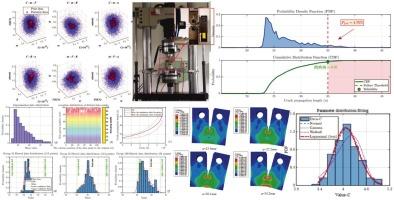Prediction of fatigue crack propagation driven by data and model collaboration with probability updates
IF 5.6
2区 工程技术
Q1 ENGINEERING, MECHANICAL
引用次数: 0
Abstract
During the service life of engineering structures, fatigue crack propagation is inherently influenced by a multitude of uncertainties, encompassing material inhomogeneities, load fluctuations, and environmental corrosion, making accurate prediction a pivotal challenge in safeguarding structural safety and reliability. This paper proposes a data and model collaborative driving method based on probability updates to achieve high-precision prediction and uncertainty quantification of fatigue crack propagation. Construct a framework by integrating fracture mechanism models, finite element simulations, Bayesian theory, and data processing techniques. Select effective parameter groups based on experimental data confidence intervals, combine maximum likelihood estimation and Akaike information criteria to determine the optimal distribution characteristics of parameters, and use a kriging model to efficiently fit complex nonlinear relationships. Leveraging probability update mechanisms and Markov chain Monte Carlo sampling techniques, the dynamic evolution of parameter distributions from prior to posterior is achieved, thereby enabling quantitative characterization of system uncertainties. Experimental verification shows that the model prediction error is less than 4%, and reliability analysis reveals the decreasing trend of reliability with the number of cycles. The results provide theoretical methods for fatigue life assessment and reliability optimization of engineering structures, and have important guiding significance for structural design and maintenance strategy formulation.

基于数据和模型协同的疲劳裂纹扩展预测与概率更新
在工程结构的使用寿命期间,疲劳裂纹的扩展受到材料不均匀性、载荷波动和环境腐蚀等诸多不确定因素的影响,因此对其进行准确预测是保障结构安全可靠的关键挑战。为了实现疲劳裂纹扩展的高精度预测和不确定性量化,提出了一种基于概率更新的数据与模型协同驱动方法。结合断裂机理模型、有限元模拟、贝叶斯理论和数据处理技术构建框架。基于实验数据置信区间选择有效参数组,结合极大似然估计和Akaike信息准则确定参数的最优分布特征,利用克里格模型高效拟合复杂非线性关系。利用概率更新机制和马尔可夫链蒙特卡罗采样技术,实现了参数分布从先验到后验的动态演化,从而实现了系统不确定性的定量表征。实验验证表明,该模型预测误差小于4%,可靠性分析显示可靠性随循环次数的增加呈下降趋势。研究结果为工程结构疲劳寿命评估和可靠性优化提供了理论方法,对结构设计和维修策略的制定具有重要的指导意义。
本文章由计算机程序翻译,如有差异,请以英文原文为准。
求助全文
约1分钟内获得全文
求助全文
来源期刊

Theoretical and Applied Fracture Mechanics
工程技术-工程:机械
CiteScore
8.40
自引率
18.90%
发文量
435
审稿时长
37 days
期刊介绍:
Theoretical and Applied Fracture Mechanics'' aims & scopes have been re-designed to cover both the theoretical, applied, and numerical aspects associated with those cracking related phenomena taking place, at a micro-, meso-, and macroscopic level, in materials/components/structures of any kind.
The journal aims to cover the cracking/mechanical behaviour of materials/components/structures in those situations involving both time-independent and time-dependent system of external forces/moments (such as, for instance, quasi-static, impulsive, impact, blasting, creep, contact, and fatigue loading). Since, under the above circumstances, the mechanical behaviour of cracked materials/components/structures is also affected by the environmental conditions, the journal would consider also those theoretical/experimental research works investigating the effect of external variables such as, for instance, the effect of corrosive environments as well as of high/low-temperature.
 求助内容:
求助内容: 应助结果提醒方式:
应助结果提醒方式:


